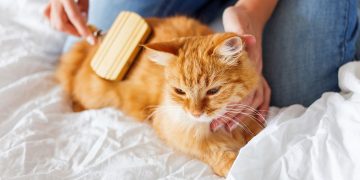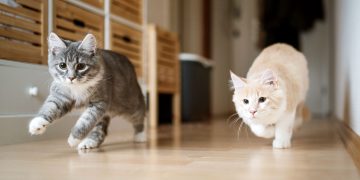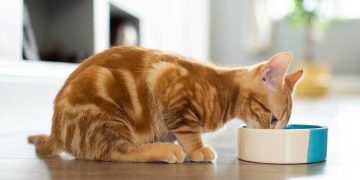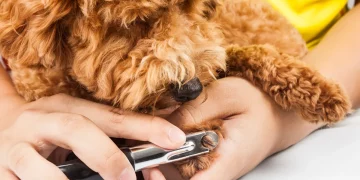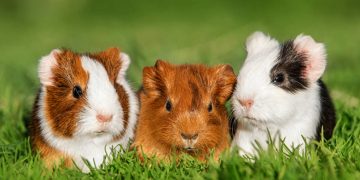- The African lion cat is a relatively new cat breed, born in the United States in the 1990s. The African lion cat English Chausie (pronounced “chow-see”); developed through the breeding of domestic cats and a species of wild cat called the jungle cat (felis chaus). From the outside, the African lion cat looks wild, but this fully domesticated breed is a sociable, affectionate and kind family pet. The African lion cat is very similar to its wild ancestor. It has a long, sloping forehead, high cheekbones, a long muzzle, a plump and slightly rounded chin, and a broad, fluffy nose. It’s big and tall, with long legs and a deep chest, but it’s not a bulky cat. African lion cats have an athletic build, with a lanky, slender body. They are built for running and jumping. The triangular-shaped ears are tall, large, and wide, with rounded tips, preferably tufts—one that sticks out from the tip of the ear. Small clumps of hair. The tail may be shorter than a typical cat tail, ranging in length from three-quarters to full length, with slightly shorter tails being preferred. The short, slightly thick coat of the African lion cat comes in three colors:
- Brown Checked Tabby (sand-grey to reddish-gold, with two to three black stripes around each hair, preferably the tail, inner front legs and hocks on the hind legs);
- Black tabby (a pattern inherited from the ancestors of the jungle cat, where the hair shafts bear lighter colors on the skin, alternating dark and light bands, and end with dark tips);
- The African Lion Cat is a very active and playful cat that needs a lot of stimulation and company. This is not the best breed for people who are away from home for many hours a day. Confident, confident, outgoing, loyal and affectionate to the human family, African Lions get along well with people of all ages, including well-respected children. They can get along peacefully with dogs and other cats if properly introduced and raised with them. History of the African lion cat The African lion cat is a crossbreed between domesticated cats and a wild species known as the jungle cat (felis chaus). The jungle cat is an ancient wild cat that has been around since the time of the ancient Egyptians, who seem to have domesticated them and kept them as pets.

- Drawings and jungle cat mummies found with human owners in Egyptian tombs attest to this. In the 1990s, some breeders in the United States began to breed a breed of domestic cat that closely resembled the jungle cat. Many different breeds of domestic cats were used in early African lion cat breeding programs, including Abyssinians and domestic cats (mixed breed shorthair cats). Eventually, breeders succeeded in developing a new breed and named it the African Lion Cat, a nickname derived from the Latin name for the jungle cat (felis chaus). The African Lion Cat has been recognized by the International Cat Association since 1995. In 2013, the breed achieved TICA championship status, allowing cats to compete for the title at cat shows.
- The short, slightly coarse coat of the African lion cat is easy to manage. Just brush with a soft brush once a week to keep shedding to a minimum. Bathe occasionally and trim your African lion cat’s nails every two to three weeks. Make sure to check the inside of your cat’s ears once a week. You should not see any redness or excessive debris in the ear. If the ears look a little dirty, clean them with a pet-safe ear cleaner and cotton balls and/or square gauze (never stick cotton swabs inside the cat’s ears). African lion cats are very active and curious cats. African lion cats are always in motion and love to play, run, jump, climb and explore, and many even enjoy the water. They’ve been known to open cupboards and rummage inside – child locks may help prevent particularly curious African lion cats from making a mess. Offers a variety of acceptable scratching surfaces, a natural and pleasant feline behavior. Scratching posts or cat trees are great for cats who like to scratch vertically. Cardboard or sisal scratchers lying on the ground are great for cats who like to scratch horizontally. African lion cats are very intelligent and love to learn new things. Described as “dog-like”, some African Lions enjoy playing hide-and-seek and even go for walks outside wearing a harness and leash.
- In general, this breed is easy to get along with and a lot of fun. They are very social cats and need a family who can keep them at home regularly to provide participation and companionship. Common Health Problems Some purebred cat breeds are prone to certain genetic-related diseases, but African lion cats are very healthy with few health problems. Diet and Nutrition Obesity is a common concern for cats, but most African lion cats are so active by nature that they are rarely overweight. Feed adult cats a high-quality diet and rations twice a day, rather than free feeding (no food all day).



